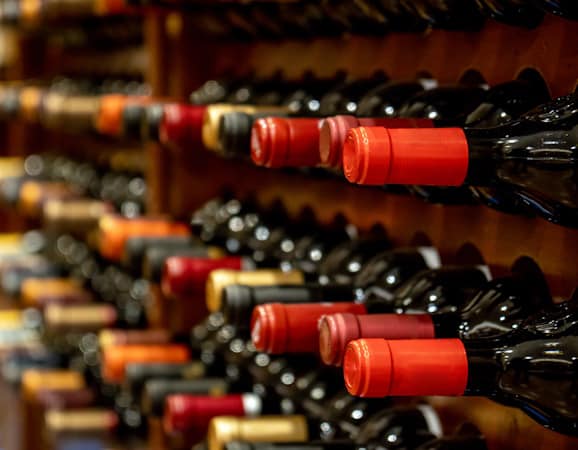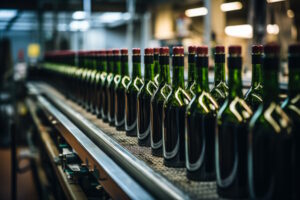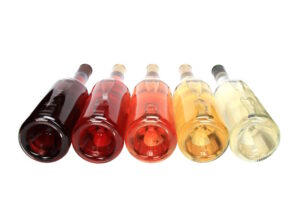
By Tom Marquardt And Patrick Darr
For decades creative marketing firms have spent wine producers’ money on creating the right bottling package to impress voters. Oftentimes, an attractive label – or a clever name — is all a consumer needs to choose one bottle over another. Years ago Far Niente became famous for its embossed label that contributed 75 cents to the bottle of its expensive chardonnay. Then came Cupcake whose name alone sold thousands of bottles (who doesn’t like a cupcake?), which spawned other food-related labels such as Bread & Butter. If that wasn’t enough, augmented wine labels – 19 Crimes, for instance – gave consumers a treat when the labels became animated when seen through a phone app.
Labels, a cute name and even the closure were meant to grab the consumer’s attention.
 But if you want to really send surefire proof to a consumer that the wine he’s about to drink is really, really expensive, put the wine in a heavier bottle. Moreso than any other wine-growing region, California has led the way in putting $100-plus wine in weighty glass. Lift a 12-bottle case of these wines and you risk a hernia.
But if you want to really send surefire proof to a consumer that the wine he’s about to drink is really, really expensive, put the wine in a heavier bottle. Moreso than any other wine-growing region, California has led the way in putting $100-plus wine in weighty glass. Lift a 12-bottle case of these wines and you risk a hernia.
Fortunately, more attention is being paid today to the environmental impact of additional bottle glass that does nothing to improve what’s inside. It comes on the heels of an international drive towards organic and sustainable farming. And, why not? If consumers want less herbicides and pesticides in their wine to help the environment, they are not going to object to a lighter bottle. Do they really care as long as the bottle isn’t more prone to breakage?
Wine’s most significant contribution of carbon is the emissions from bottle manufacture. A study sponsored by the Wine Institute estimated a bottle contributes 28 percent to the carbon footprint of wine production. Bag-in-the-box packaging would reduce the carbon footprint by an estimated 40 percent, although it would be a quantum leap for consumers to associate a bag with quality.
We were struck by the sudden differences in bottle weight when we sampled several wines over a couple of days. Here is what we found with the association of bottle weight to the wine’s price:
 Casa Santos Lima – 395 grams — $15
Casa Santos Lima – 395 grams — $15
Cormorant sauvignon blanc – 487 grams — $24
Kirkland Barolo – 568 grams — $20
Penfolds California Bin 704 Cabernet Sauvignon – 721 grams — $70
Newton – 796 grams – $135
The Thomas Collection — 1,215 grams — $330
Fortunately, there is a global movement afoot to commit wine producers to a lighter bottle. An international agreement initiated by the Sustainable Wine Roundtable that includes Whole Foods and Naked Wines advocates lowering the weight of a regular bottle to 420 grams.
Recently, Ancient Peaks Winery announced that several of its 2020 wines will be packaged in bottles weighing 42 percent less. And, Ron Rubin wines has Blue Bin wines – a rosé pinot grigio, sauvignon blanc and chardonnay — in ultra-light-weight bottles for $15 each. The bottles are made of recycled plastic and lined with a thin layer of glass. They are ultra-light and can be tossed in a cooler without adding much weight.
We are confident the pressure being applied on producers eventually will alter the course of wine packaging that will save money for bottlers and save the environment for us.
Cordant
Cordant winery draws fruit from Monterey County through Santa Barbara County, a distance that covers nearly 200 miles. Generally, its wines fall into two groups: the conventional pinot noir/chardonnay and Rhone-style wines made from syrah, grenache and mourvedre.
We have tasted these wines from previous vintages, but the 2021 wines are even better.
Said Cordant founder David Taylor, “We believe the 2021 vintage will go down as one of the better vintages we have experienced in California. Although it was considered a drought year, we had lower temperatures during the primary growing season than we sometimes experience. This resulted in smaller grape clusters that were able to ripen over a longer period of time. As a result, the wines have depth and concentration while also maintaining a sinewy and layered texture.”

Cordant Indocile 2021 ($65). New to the Cordant family is this blend of 86 percent syrah and 14 percent grenache. Taylor said the goal was to “craft a wine whose style emulates the wines of Northern Rhone, that we would be proud to pour alongside producers from that area.” He said that although the 14 percent grenache was somewhat uncommon in Northern Rhone, his team felt it helped to achieve a stylistic goal in 2021. We loved the mix of dark fruit notes and classic Rhone lavender and herbs. Well balanced with intensity and silkiness.
Cordant Radian Vineyard Pinot Noir 2021 ($70). Radian Vineyard in Sta. Rita Hills benefits from cooling fogs off the Pacific Ocean – ideal for pinot noir. There are generous black cherry and lavender aromas with rich red berry flavors and long finish.
Cordant Manical 2021 ($65). By far our favorite of the fabulous Cordant lineup, this blend of grenache, syrah and mourvedre was inspired by the red blends of the Southern Rhone. Sourcing grapes from the west side of Paso Robles, the wine has floral, lavender aromas with wild blackberry flavors and a fetching hint of spice and herbs.
Cordant Escolle Vineyard Pinot Noir 2021 ($70). This wine made from grapes grown in Santa Lucia Highlands is smooth and delicious with layers of red berry fruit and a hint of menthol and spice.
Wine picks

Enrico Serafino Picotener Langhe DOC 2020 ($30). One of the oldest wineries in Piedmont, Enrico offers a tasty and unique sub-variety of nebbiolo. The ancient and forgotten picotener grape variety offers expressive lavender and violet aromas plus plum and cherry flavors.
Francis Coppola Sauvignon Blanc 2022 ($15). This easy-to-drink sauvignon blanc has ample citrus and grapefruit notes with balanced acidity.
Ferrari-Carano Fume Blanc North Coast 2022 ($21). This is a very elegant sauvignon blanc featuring pear and citrus elements and a satisfying mouthfeel. Aged in stainless steel and neutral French oak.
Republished with permission
Tom Marquardt and Patrick Darr have been writing a weekly wine column for more than 30 years. Additional Wine reviews on MoreAboutWine
All photos are randomly selected and do not indicate any preferred wine. Listed prices are subject to change and do not include tax or shipping.
You can send questions to Tom Marquardt marq1948@gmail.com
Always drink responsibly![/vc_message]
Disclaimer
The information contained in South Florida Reporter is for general information purposes only.
The South Florida Reporter assumes no responsibility for errors or omissions in the contents of the Service.
In no event shall the South Florida Reporter be liable for any special, direct, indirect, consequential, or incidental damages or any damages whatsoever, whether in an action of contract, negligence or other tort, arising out of or in connection with the use of the Service or the contents of the Service. The Company reserves the right to make additions, deletions, or modifications to the contents of the Service at any time without prior notice.
The Company does not warrant that the Service is free of viruses or other harmful components












